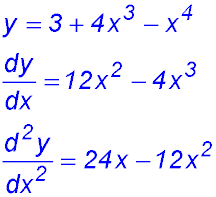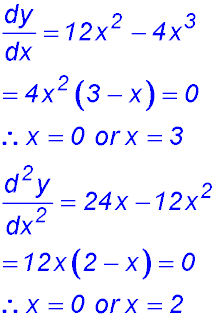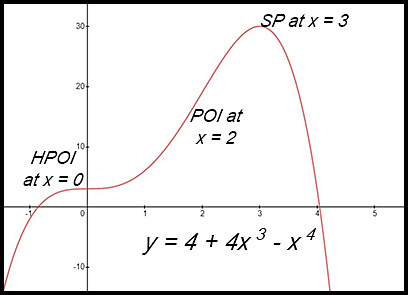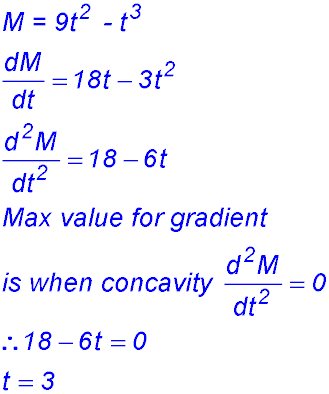Where the techniques of Maths
are explained in simple terms.
Calculus - Differentiation - Applications of Calculus.
2nd derivative - Concavity -Test Yourself 1 - Solutions.
- Algebra & Number
- Calculus
- Financial Maths
- Functions & Quadratics
- Geometry
- Measurement
- Networks & Graphs
- Probability & Statistics
- Trigonometry
- Maths & beyond
- Index
Now for the solutions:
| Find the concavity. | 1. Find the concavity function for the curve given by y = x3(x - 2). | 2. Determine the value of the concavity for the function
y = (1 - 3x)3 at x = 1 and interpret its sign graphically. |
||||||||||||||||
| Finding points of concavity change. | 3. Find the point(s) on the curve
y = x3 - 3x2 - 9x + 11 where the concavity changes sign. |
4. Find the point(s) on the curve
y = 12x3 -3x4 + 11 where the concavity changes sign. |
||||||||||||||||
5. Find the regions on the curve y = x3 - x2 - 4x - 3 where the curve is
|
6. Find the regions on the curve y = 27x - x3 where the the curve is
|
|||||||||||||||||
| Interpreting concavity of a curve. | 7. Show that the curve
is always concave down. |
8. Show that the curve
is always concave up when x > 0. |
||||||||||||||||
9. (i) the first two derivatives:
(ii) (iii) At x = 3, there appears to be a stationary point. Substituting x = 3 into the 2nd derivative gives a value of -36 which implies there is a maximum point at x = 3. At x = 2 there is a point of inflection. Testing:
Change of sign ∴ a change in concavity. POI. At x = 0, both derivatives = 0. Hence the gradient and the inflection = 0. ∴ possible horizontal point of inflection. Checking for a gradient change about x = 0:
There is no gradient change from positive. ∴ horizontal POI at x = 0. (iv) |
10. For the curve y = 2x4 - 4x3 + 2x2 + 10:
|
|||||||||||||||||
| 1st and 2nd derivative combinations. | 11. The first and second derivative functions of a curve are:
f '(x) = x(x - 3)(x + 5) f "(x) = 3x2 + 4x -15
|
12. If g(x) = x + 2x2, solve the equation
g '(a) = g "(a). |
||||||||||||||||
| 13. Find the values for a, b and c if the curve y = x3 + ax2 - bx + c has a
|
14. Given the equation y = x3 - x2 - x + 6,
find the x values where the curve is both decreasing and concave up. |
|||||||||||||||||
15. The graph of f(x) = 7 + 5x - x2 - x3 is defined in the domain [-3, 3].
Answer.(i) Maximum at (1, 10) and minimum at (-5/3, 14/27). (ii) POI at (-1/3, 148/27). (iv) Concave up for (-3, -1/3). |
16. (i) 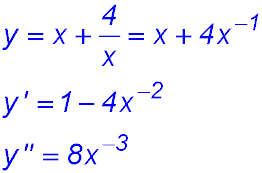
(ii) the two stationary points:
(iii) Sketch the curve. (iv) For what values of x is the curve concave up? Answer.(ii) Min at (2, 4)Max at (-2, -4), (iv) Concave up for x > 0. | |||||||||||||||||
| 17. Consider the function f(x) = x3 - x2 - 5x + 1. Answer.(i) Max at (-1, 4) Min at (5/3, -5.48). (ii) POI at (1/3, 0.74). (iv) [1/3, 2]. |
18. For the function f(x) = 8x3 - 8x2:
Answer.(i) Max at (0, 0) Min at (2/3, -1.185). (ii) POI at (1/3, -0.59). (iv) 0 < x < 1/3. |
|||||||||||||||||
| Maximum gradient. | 19. Find the maximum gradient of the curve y = x3 - 6x2 + 5 |
20. Could use the 1st derivative and draw the parabola. Could also use a table to prove zero concavity. |
||||||||||||||||
20. |
21. |
|||||||||||||||||
22. Prove that the graph of y = ax3 + bx2 + cx + d Find the values of a, b, c and d for which the graph of this form has turning points at (0.5, 1) and at (1.5, -1) |
23. |


